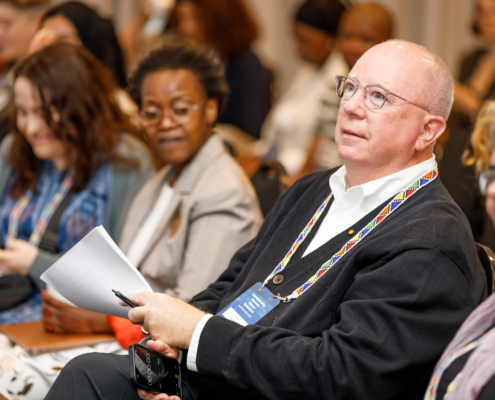28 November 2024
Basic, or foundational, science encompasses a vast range of research—from studying the atomic structure of materials to the formation of galaxies. It is often described as the stuff of wonder and awe. Yet, despite its importance, basic science has historically been underrepresented in science communication and public engagement efforts, which have tended to focus more on applied science, emerging technologies, or controversial research.
The Communicating Discovery Science Symposium, held from 18 to 20 November in Stellenbosch, aimed to bridge this gap. The event brought together scientists and science communication experts to discuss the nuances of, and the research behind, communicating basic science. Over the course of three days, attendees shared their insights and explored ways to enhance their communication practices.
(From right) John Besley, Professor at Michigan State University and Sara K. Yeo, Associate Professor at the University of Utah, during a panel discussion on building infrastructure for effective discovery science communication. (Credit: Petro Kotzé)
Rick Borchelt (Scientific Committee Chair, USA) at the recent Communicating Discovery Science Symposium. (Credit: Ignus Dreyer, Stellenbosch University)
A milestone in science communication
The symposium was organised by the Stellenbosch University’s Centre for Research on Evaluation, Science and Technology (CREST) under the leadership of Prof Marina Joubert. A senior researcher and leading figure in the field, Prof Joubert has played a pivotal role in establishing Africa’s first academic programme dedicated to public science communication and engagement. The event was made possible through the support of the Kavli Foundation, which sponsored its first-ever science communication symposium in Africa—a significant milestone that fostered international exchange and learning.
The symposium’s origins trace back to an initiative launched four years ago through a partnership between the Kavli Foundation and the U.S. Department of Energy Office of Science: the Science Public Engagement Partnership (SciPEP). This initiative aims to deepen understanding of effective public engagement around basic research.
Key themes and discussions
The symposium focused on the evolution of science communication of basic sciences and its future direction. Key themes included the relevance of basic science in contemporary society and the importance of maintaining curiosity and awe in communication efforts. Attendees agreed on the need for a unified approach to science communication while also recognising the value of diversity in enriching the field.
Prof Joubert highlighted how the diverse lineup of speakers brought unique insights to the table, striking a balance between theory and practical application. The program featured a dynamic mix of young, enthusiastic researchers and seasoned professionals, fostering a rich exchange of ideas and experiences.
Notable speakers and presentations
From the academic sphere, several distinguished speakers shared their insights on enhancing science communication. Dr Bruce Lewenstein, a renowned expert in science communication from Cornell University, discussed how public engagement can influence scientific research. He emphasised the importance of fostering mutual benefit in science communication, where both the public and researchers gain from their interactions. Dr John Besley, a professor at Michigan State University, highlighted the importance of setting audience-specific behavioural goals in science communication, arguing that its ultimate aim should be to influence specific behaviours. Stellenbosch University’s Prof Nokwanda (Nox) Makunga spoke about communicating the basics of botany, highlighting the need to address plant blindness, promote plant awareness and engage communities.
Jeanne Garbarino, Executive Director of RockEDU Science Outreach at Rockefeller University, spoke about the civic science movement, emphasising that everyone can shape scientific discoveries and their societal implications.
The symposium also featured speakers focused on practical approaches to science communication. Chris Eksteen from the Cape Leopard Trust shared insights from the ‘Footprints in the Fynbos’ project, which uses multilingual and accessible materials, including braille and audio formats, to make science more inclusive and engaging for diverse communities. Luther Chipembere from the Stellenbosch University African Doctoral Academy explored TikTok’s potential as a dynamic platform for effective science communication. Melanie Brown, a BBC science journalist and producer of the popular podcast Infinite Monkey Cage, discussed how humour can make complex scientific concepts more accessible and engaging for the public.
Over 130 attendees from 13 countries joined them to discuss the evolving role of foundational science in contemporary society.
Closing remarks and future directions
In his closing remarks, Rick Borchelt, the recently retired Director of Communications and Public Affairs at the U.S. Department of Energy’s Office of Science, noted that while much progress had been made, efforts to bridge the gap between research and public engagement must continue.
Michelle Riedlinger, Editor-in-Chief of the Journal of Science Communication (JCOM) and Associate Professor at Queensland University of Technology, highlighted the importance of evolving communication practices and stressed the need to ensure that foundational science remains relevant and accessible to the public.
The symposium marked a pivotal moment in the ongoing efforts to enhance basic science communication. Moving forward, there is a clear commitment to ensuring that a broader, more diverse audience understands and appreciates the awe-inspiring world of basic research.




